Coupling and Quantifying Sustainability and Resilience in Intelligent Buildings
Abstract
:1. Introduction
- Quantify the resilience of smart building systems.
- Couple both sustainability and resilience using a cost–benefit evaluation method.
- The contributions of this study to the business are summarized in the following points:
- Measure the financial damages that might occur when resilience is not coupled with sustainability.
- Minimize the possible financial losses and turn them into a potential profit.
2. Literature Review
2.1. Methods to Assess and Quantify Sustainability
2.2. Resilience Definition and Dimensions
2.3. Methods to Assess and Quantify Resilience
2.4. Integrating New Technologies in Buildings to Create Intelligent Buildings
2.5. Coupling Sustainability and Resilience
2.5.1. Environmental Attributes
2.5.2. Social Attributes
2.5.3. Economic Attributes
3. Materials and Methods
3.1. Data Collection
3.2. Model Formulation
3.3. Survey Development
3.4. Indices Quantification and Weights
| Extremely important | 5 |
| Very important | 4 |
| Somewhat important | 3 |
| Not so important | 2 |
| Not at all important | 1 |
3.5. Assessing the Resilience of Smart Systems in Buildings
- A pessimistic scenario (P): Fault cost = 30% waste of the total energy.
- An optimistic scenario (O): Fault cost = 15% waste of the total energy.
- A most likely scenario (M): Fault cost = 20% waste of the total energy [70].
4. Results and Analysis
4.1. Sustainability Calculations
4.1.1. Environmental Aspect Calculations
4.1.2. Social Aspect Calculations
4.1.3. Economic Aspect Calculations
4.2. Resilience Calculations
5. Discussion
6. Conclusions and Recommendations
Author Contributions
Funding
Institutional Review Board Statement
Informed Consent Statement
Data Availability Statement
Conflicts of Interest
References
- Bocchini, P.; Frangopol, D.M.; Ummenhofer, T.; Zinke, T. Resilience and sustainability of civil infrastructure: Toward a unified approach. J. Infrastruct. Syst. 2014, 20, 04014004. [Google Scholar] [CrossRef]
- Alwaer, H.; Clements-Croome, D.J. Key performance indicators (KPIs) and priority setting in using the multi-attribute approach for assessing sustainable intelligent buildings. Build. Environ. 2010, 45, 799–807. [Google Scholar] [CrossRef]
- Rafiei, M.H.; Adeli, H. Sustainability in highrise building design and construction. Struct. Des. Tall Spec. Build. 2016, 25, 643–658. [Google Scholar] [CrossRef]
- McLellan, B.; Zhang, Q.; Farzaneh, H.; Utama, N.A.; Ishihara, K.N. Resilience, sustainability and risk management: A focus on energy. Challenges 2012, 3, 153–182. [Google Scholar] [CrossRef]
- Grafakos, S.; Gianoli, A.; Tsatsou, A. Towards the development of an integrated sustainability and resilience benefits assessment framework of urban green growth interventions. Sustainability 2016, 8, 461. [Google Scholar] [CrossRef]
- Chen, Z.; Wang, F.; Feng, Q. Cost-benefit evaluation for building intelligent systems with special consideration on intangible benefits and energy consumption. Energy Build. 2016, 128, 484–490. [Google Scholar] [CrossRef]
- John, G.; Clements-Croome, D.; Jeronimidis, G. Sustainable building solutions: A review of lessons from the natural world. Build. Environ. 2005, 40, 319–328. [Google Scholar] [CrossRef]
- Cole, R.J. Emerging trends in building environmental assessment methods. Build. Res. Inf. 1998, 26, 3–16. [Google Scholar] [CrossRef]
- Salvalai, G.; Sesana, M.M. Monitoring Approaches for New-Generation Energy Performance Certificates in Residential Buildings. Buildings 2022, 12, 469. [Google Scholar] [CrossRef]
- Sartori, T.; Drogemuller, R.; Omrani, S.; Lamari, F. A schematic framework for Life Cycle Assessment (LCA) and Green Building Rating System (GBRS). J. Build. Eng. 2021, 38, 102180. [Google Scholar] [CrossRef]
- Yao, F.; Liu, G.; Ji, Y.; Tong, W.; Du, X.; Li, K.; Shrestha, A.; Martek, I. Evaluating the environmental impact of construction within the industrialized building process: A monetization and building information modelling approach. Int. J. Environ. Res. Public Health 2020, 17, 8396. [Google Scholar] [CrossRef] [PubMed]
- Backes, J.G.; Traverso, M. Life Cycle Sustainability Assessment in the construction sector–actual application and future outlook. In E3S Web of Conferences; EDP Sciences: Les Ulis, France, 2022; Volume 349, p. 04007. [Google Scholar]
- Abdalla, H.; Fattah, K.; Abdallah, M.; Al-Tamimi, A. Environmental footprint and economics of a full-scale 3D-printed house. Sustainability 2021, 13, 11978. [Google Scholar] [CrossRef]
- Islam, H.; Bhuiyan, M.; Tushar, Q.; Navaratnam, S.; Zhang, G. Effect of Star Rating Improvement of Residential Buildings on Life Cycle Environmental Impacts and Costs. Buildings 2022, 12, 1605. [Google Scholar] [CrossRef]
- Ferrari, S.; Zoghi, M.; Blázquez, T.; Dall’O’, G. New Level(s) framework: Assessing the affinity between the main international Green Building Rating Systems and the european scheme. Renew. Sustain. Energy Rev. 2022, 155, 111924. [Google Scholar] [CrossRef]
- Remer, D.S.; Nieto, A.P. A compendium and comparison of 25 project evaluation techniques. Part 1: Net present value and rate of return methods. Int. J. Prod. Econ. 1995, 42, 79–96. [Google Scholar] [CrossRef]
- Gluch, P.; Baumann, H. The life cycle costing (LCC) approach: A conceptual discussion of its usefulness for environmental decision-making. Build. Environ. 2004, 39, 571–580. [Google Scholar] [CrossRef]
- Wong, J.K.W.; Li, H.; Wang, S.W. Intelligent building research: A review. Autom. Constr. 2005, 14, 143–159. [Google Scholar] [CrossRef]
- Sutter, C.; Parreño, J.C. Does the current Clean Development Mechanism (CDM) deliver its sustainable development claim? An analysis of officially registered CDM projects. Clim. Change 2007, 84, 75–90. [Google Scholar] [CrossRef]
- Wardekker, J.A.; de Jong, A.; Knoop, J.M.; van der Sluijs, J.P. Operationalising a resilience approach to adapting an urban delta to uncertain climate changes. Technol. Forecast. Soc. Change 2010, 77, 987–998. [Google Scholar] [CrossRef]
- Holling, C.S. Resilience and stability of ecological systems. Annu. Rev. Ecol. Syst. 1973, 1, 1–23. [Google Scholar] [CrossRef]
- Nan, C.; Sansavini, G. A quantitative method for assessing resilience of interdependent infrastructures. Reliab. Eng. Syst. Saf. 2017, 157, 35–53. [Google Scholar] [CrossRef]
- Bignami, D.F. Testing solutions of a multi-disaster building’s certification functional to the built environment sustainability and resilience. Int. J. Disaster Resil. Built Environ. 2017, 8, 77–97. [Google Scholar] [CrossRef]
- Cox, R.A.; Nielsen, S.B.; Rode, C. Coupling and quantifying resilience and sustainability in facilities management. J. Facil. Manag. 2015, 13, 314–331. [Google Scholar] [CrossRef]
- Nedelcu, A.-V.; Sandu, F.; Machedon-Pisu, M.; Alexandru, M.; Ogrutan, P. Wireless-based remote monitoring and control of intelligent buildings. In Proceedings of the 2009 IEEE International Workshop on Robotic and Sensors Environments, Lecco, Italy, 6–7 November 2009; pp. 47–52. [Google Scholar]
- Štěpán, P.; Prostejovska, Z. IoT in buildings and optimization of energy consumption. Bus. IT 2020, X, 32–41. [Google Scholar] [CrossRef]
- Patidar, A.; Sharma, M.; Agrawal, R.; Sangwan, K.S. Supply chain resilience and its key performance indicators: An evaluation under industry 4.0 and sustainability perspective. Manag. Environ. Qual. Int. J. 2022, 34, 962–980. [Google Scholar] [CrossRef]
- Huang, Y.; Shen, T. An article on green firefighting equipment in Taiwan. Sustainability 2021, 13, 12421. [Google Scholar] [CrossRef]
- Li, P.; Wu, J. Sustainable living with risks: Meeting the challenges. Hum. Ecol. Risk Assess. Int. J. 2019, 25, 1–10. [Google Scholar] [CrossRef]
- Mortula, M.; Ahmad, I.; Sadiq, R.; Beheiry, S. A Conceptual Unified Model for Assessing Improvements in Sustainability and Resilience in Water Distribution Systems; Springer eBooks: Berlin/Heidelberg, Germany, 2021. [Google Scholar] [CrossRef]
- Doukas, H.; Patlitzianas, K.D.; Iatropoulos, K.; Psarras, J. Intelligent building energy management system using rule sets. Build. Environ. 2007, 42, 3562–3569. [Google Scholar] [CrossRef]
- Wong, J.K.W.; Li, H. Application of the analytic hierarchy process (AHP) in multi-criteria analysis of the selection of intelligent building systems. Build. Environ. 2008, 43, 108–125. [Google Scholar] [CrossRef]
- Jin, X.H.; Zhang, G.; Zuo, J.; Lindsay, S. Sustainable high-rise design trends-Dubai’s strategy. Civ. Eng. Archit. 2013, 1, 33–41. [Google Scholar] [CrossRef]
- Chew, I.; Kalavally, V.; Oo, N.W.; Parkkinen, J. Design of an energy-saving controller for an intelligent LED lighting system. Energy Build. 2016, 120, 1–9. [Google Scholar] [CrossRef]
- Alibabaei, N.; Fung, A.; Raahemifar, K.; Moghimi, A. Effects of intelligent strategy planning models on residential HVAC system energy demand and cost during the heating and cooling seasons. Appl. Energy 2017, 185, 29–43. [Google Scholar] [CrossRef]
- Koumoutsos, K.; Kretsis, A.; Kokkinos, P.; Varvarigos, E.A.; Nikolopoulos, V.; Gkioxi, E.; Zafeiropoulos, A. Gathering and processing energy consumption data from public educational buildings over IPv6. Energy Sustain. Soc. 2015, 5, 1–12. [Google Scholar] [CrossRef]
- Reda, F.; Pasini, D.; Laitinen, A.; Vesanen, T. ICT intelligent support solutions toward the reduction of heating demand in cold and mild European climate conditions. Energy Effic. 2019, 12, 1443–1471. [Google Scholar] [CrossRef]
- Hofer, G.; Herzog, B.; Grim, M. Calculating life cycle cost in the early design phase to encourage energy efficient and sustainable buildings. Proc. IEECB Focus 2010, 2, 3–4. [Google Scholar]
- King, J.; Perry, C. Smart Buildings: Using Smart Technology to Save Energy in Existing Buildings; Amercian Council for an Energy-Efficient Economy: Washington, DC, USA, 2017. [Google Scholar]
- Lazarova-Molnar, S.; Shaker, H.R.; Mohamed, N. Fault detection and diagnosis for smart buildings: State of the art, trends and challenges. In Proceedings of the 2016 3rd MEC International Conference on Big Data and Smart City (ICBDSC), Muscat, Oman, 15–16 March 2016; pp. 1–7. [Google Scholar]
- Lazarova-Molnar, S.; Mohamed, N. A framework for collaborative cloud-based fault detection and diagnosis in smart buildings. In Proceedings of the 2017 7th International Conference on Modeling, Simulation, and Applied Optimization (ICMSAO), Sharjah, United Arab Emirates, 4–6 April 2017; pp. 1–6. [Google Scholar]
- Weng, T.; Agarwal, Y. From buildings to smart buildings—Sensing and actuation to improve energy efficiency. IEEE Des. Test Comput. 2012, 29, 36–44. [Google Scholar] [CrossRef]
- Shen, W.; Xue, H.H.; Newsham, G.; Dikel, E. Smart building monitoring and ongoing commissioning: A case study with four canadian federal government office buildings. In Proceedings of the 2017 IEEE International Conference on Systems, Man, and Cybernetics (SMC), Banff, AB, Canada, 5–8 October 2017; pp. 176–181. [Google Scholar]
- Tokody, D.; Papp, J.; Iantovics, L.B.; Flammini, F. Complex, resilient and smart systems. In Resilience of Cyber-Physical Systems; Springer: Cham, Switzerland, 2019; pp. 3–24. [Google Scholar]
- Gaonkar, P.; Bapat, J.; Das, D. A survey on QoE and energy cost optimization strategies for smart buildings. CSI Trans. ICT 2018, 6, 195–202. [Google Scholar] [CrossRef]
- García, O.; Chamoso, P.; Prieto, J.; Rodríguez, S.; de la Prieta, F. A serious game to reduce consumption in smart buildings. In Proceedings of the International Conference on Practical Applications of Agents and Multi-Agent Systems, Porto, Portugal, 21–23 June 2017; Springer: Cham, Switzerland, 2017; pp. 481–493. [Google Scholar]
- Minoli, D.; Sohraby, K.; Occhiogrosso, B. IoT considerations, requirements, and architectures for smart buildings—Energy optimization and next-generation building management systems. IEEE Internet Things J. 2017, 4, 269–283. [Google Scholar] [CrossRef]
- Dubai Electricity & Water Authority. Shams Dubai FAQ. Dubai Electricity & Water Authority (DEWA). 2022. Available online: https://www.dewa.gov.ae/en/consumer/solar-community/shams-dubai/shams-dubai-faq (accessed on 19 February 2021).
- Nguyen, T.A.; Aiello, M. Energy intelligent buildings based on user activity: A survey. Energy Build. 2013, 56, 244–257. [Google Scholar] [CrossRef]
- Katzev, R. The impact of energy-efficient office lighting strategies on employee satisfaction and productivity. Environ. Behav. 1992, 24, 759–778. [Google Scholar] [CrossRef]
- Clark, D.; Merz, S.K. Incentives for sustainable buildings in Australia—A designer’s perspective. Sinclair Kn. Merz Tech. Pap. 2003, 2, 1–7. [Google Scholar]
- Lützkendorf, T.; Lorenz, D. Sustainable property investment: Valuing sustainable buildings through property performance assessment. Build. Res. Inf. 2005, 33, 212–234. [Google Scholar] [CrossRef]
- Papagiannidis, S.; Marikyan, D. Smart offices: A productivity and well-being perspective. Int. J. Inf. Manag. 2020, 51, 102027. [Google Scholar] [CrossRef]
- Sihite, M.; Sule, E.T.; Azis, Y.; Kaltum, U. Gain competitive advantage through reputation. South East Asia J. Contemp. Bus. Econ. Law 2016, 10, 22–31. [Google Scholar]
- Yiu, C.Y. Intelligent building maintenance—A novel discipline. J. Build. Apprais. 2008, 3, 305–317. [Google Scholar] [CrossRef]
- Asimakopoulou, E.; Bessis, N. Buildings and crowds: Forming smart cities for more effective disaster management. In Proceedings of the 2011 Fifth International Conference on Innovative Mobile and Internet Services in Ubiquitous Computing, Seoul, Republic of Korea, 30 June–2 July 2011; pp. 229–234. [Google Scholar]
- Akkaya, K.; Guvenc, I.; Aygun, R.; Pala, N.; Kadri, A. IoT-based occupancy monitoring techniques for energy-efficient smart buildings. In Proceedings of the 2015 IEEE Wireless Communications and Networking Conference Workshops (WCNCW), New Orleans, LA, USA, 9–12 March 2015; pp. 58–63. [Google Scholar]
- Mara, P.; Brennan, R.; O’Sullivan, D.; Keane, M.; McGlinn, K.; O’Donnell, J. Pervasive knowledge-based networking for maintenance inspection in smart buildings. In Proceedings of the 6th International Workshop on Managing Ubiquitous Communications and Services, Nice, France, 2–4 September 2009; pp. 59–66. [Google Scholar]
- Abate, A.; Budde, C.E.; Cauchi, N.; Hoque, K.A.; Stoelinga, M. Assessment of maintenance policies for smart buildings: Application of formal methods to fault maintenance trees. In Proceedings of the European Conference of the Prognostics and Health Management Society, Utrecht, The Netherlands, 3–6 July 2018. [Google Scholar]
- Pătraşcu, M.; Drăgoicea, M. Integrating agents and services for control and monitoring: Managing emergencies in smart buildings. In Service Orientation in Holonic and Multi-Agent Manufacturing and Robotics; Springer: Cham, Switzerland, 2014; pp. 209–224. [Google Scholar]
- Murphy, K.E.; Simon, S.J. Using cost benefit analysis for enterprise resource planning project evaluation: A case for including intangibles. In Enterprise Resource Planning: Global Opportunities and Challenges; IGI Global: Hershey, PA, USA, 2002; pp. 245–266. [Google Scholar]
- Kneifel, J. Life-cycle carbon and cost analysis of energy efficiency measures in new commercial buildings. Energy Build. 2010, 42, 333–340. [Google Scholar] [CrossRef]
- Trading Economics. United Arab Emirates Interest Rate—2023 Data—2007–2022 Historical—2024 Forecast. Trading Economics|20 Million Indicators from 196 Countries. 2022. Available online: https://tradingeconomics.com/united-arab-emirates/interest-rate (accessed on 30 March 2022).
- Rajgor, M.; Paresh, C.; Dhruv, P.; Chirag, P.; Dhrmesh, B. RII & IMPI: Effective techniques for finding delay in construction project. Int. Res. J. Eng. Technol. 2016, 3, 1173–1177. [Google Scholar]
- Baraniuk, C. Smart Buildings Predict When Critical Systems Are about to Fail. New Scientist. 2017. Available online: https://www.newscientist.com/article/2118499-smart-buildings-predict-when-critical-systems-are-about-to-fail/ (accessed on 30 March 2022).
- Ihasalo, H. Transforming Building Automation Data into Building Performance Metrics-Design, Implementation and Evaluation of Use of a Performance Monitoring and Management System. Ph.D. Thesis, Aalto University, Espoo, Finland, 2012. [Google Scholar]
- Zhao, Y.; Li, T.; Zhang, X.; Zhang, C. Artificial intelligence-based fault detection and diagnosis methods for building energy systems: Advantages, challenges and the future. Renew. Sustain. Energy Rev. 2019, 109, 85–101. [Google Scholar] [CrossRef]
- Lin, G.; Pritoni, M.; Chen, Y.; Granderson, J. Development and implementation of fault-correction algorithms in fault detection and diagnostics tools. Energies 2020, 13, 2598. [Google Scholar] [CrossRef]
- Cort, K.A.; Haack, J.N.; Katipamula, S.; Nicholls, A.K. VOLTTRON™: Tech-to-Market Best-Practices Guide for Small-and Medium-Sized Commercial Buildings; No. PNNL-25405; Pacific Northwest National Lab. (PNNL): Richland, WA, USA, 2016. [Google Scholar]
- Wu, S.; Sun, J.-Q. Cross-level fault detection and diagnosis of building HVAC systems. Build. Environ. 2011, 46, 1558–1566. [Google Scholar] [CrossRef]
- Pan, W.; Zhang, Z. Benchmarking the sustainability of concrete and steel modular construction for buildings in urban development. Sustain. Cities Soc. 2023, 90, 104400. [Google Scholar] [CrossRef]
- Sureeyatanapas, P. Comparison of rank-based weighting methods for multi-criteria decision making. Eng. Appl. Sci. Res. 2016, 43, 376–379. [Google Scholar]
- Moretti, M.; Djomo, S.N.; Azadi, H.; May, K.; De Vos, K.; Van Passel, S.; Witters, N. A systematic review of environmental and economic impacts of smart grids. Renew. Sustain. Energy Rev. 2017, 68, 888–898. [Google Scholar] [CrossRef]
- Chen, J.; Chen, Y.; Zhou, Y.; Luo, X.; Tang, Q. Insight into adsorption of cesium ion in aqueous solution based on inorganic modified bentonite. Pol. J. Environ. Stud. 2023, 32, 1565–1580. [Google Scholar] [CrossRef]
- Yu, J.Q.; Dang, B.; Clements-Croome, D.; Xu, S. Sustainability Assessment Indicators and Methodology for Intelligent Buildings. Adv. Mater. Res. 2011, 368–373, 3829–3832. [Google Scholar] [CrossRef]
- Gadakari, T.; Mushatat, S.; Newman, R. Intelligent Buildings: Key to Achieving Total Sustainability in the Built Environment. J. Eng. Proj. Prod. Manag. 2014, 4, 2–16. [Google Scholar] [CrossRef]
- Wang, L.; Xue, X.; Wang, Z.; Zhang, L. A unified assessment approach for urban infrastructure sustainability and resilience. Adv. Civ. Eng. 2018, 2018, 2073968. [Google Scholar] [CrossRef]
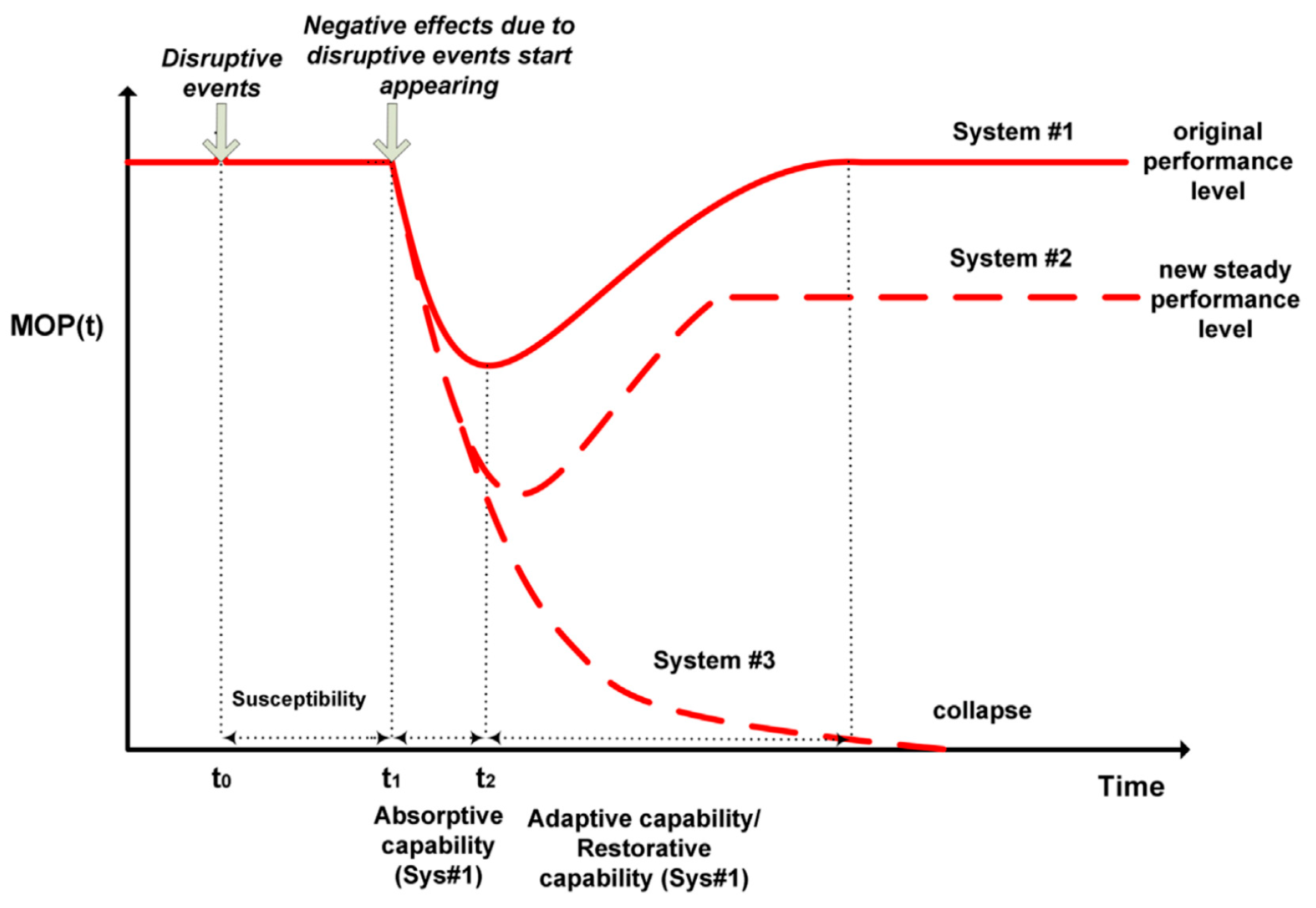
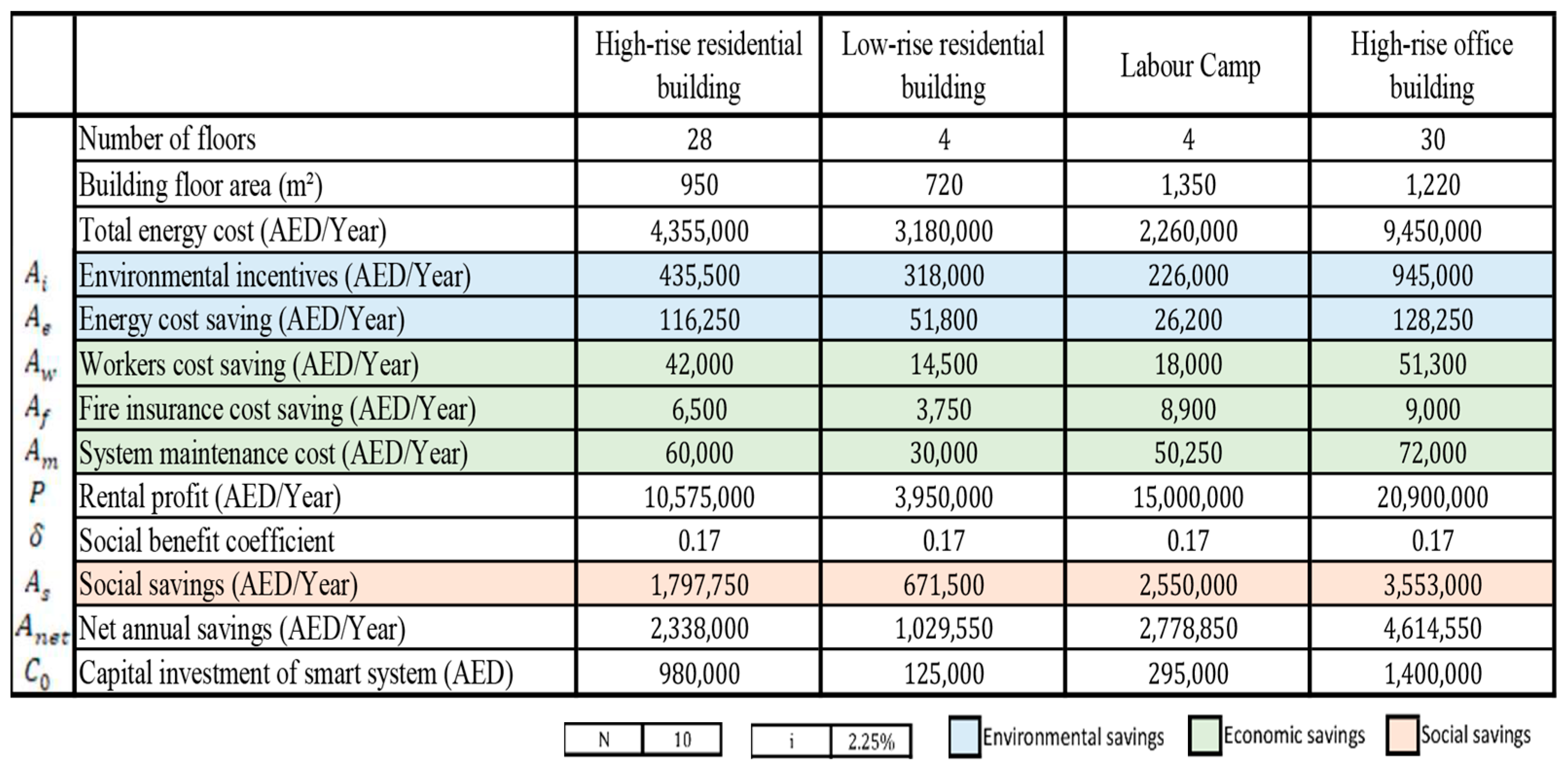


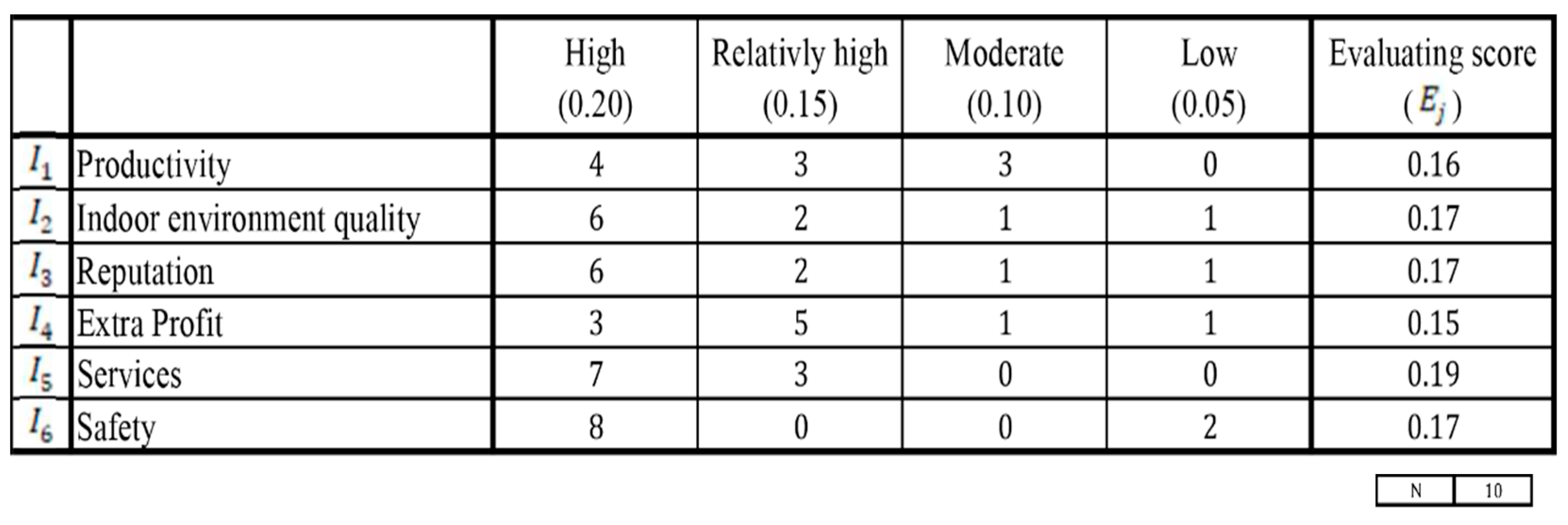

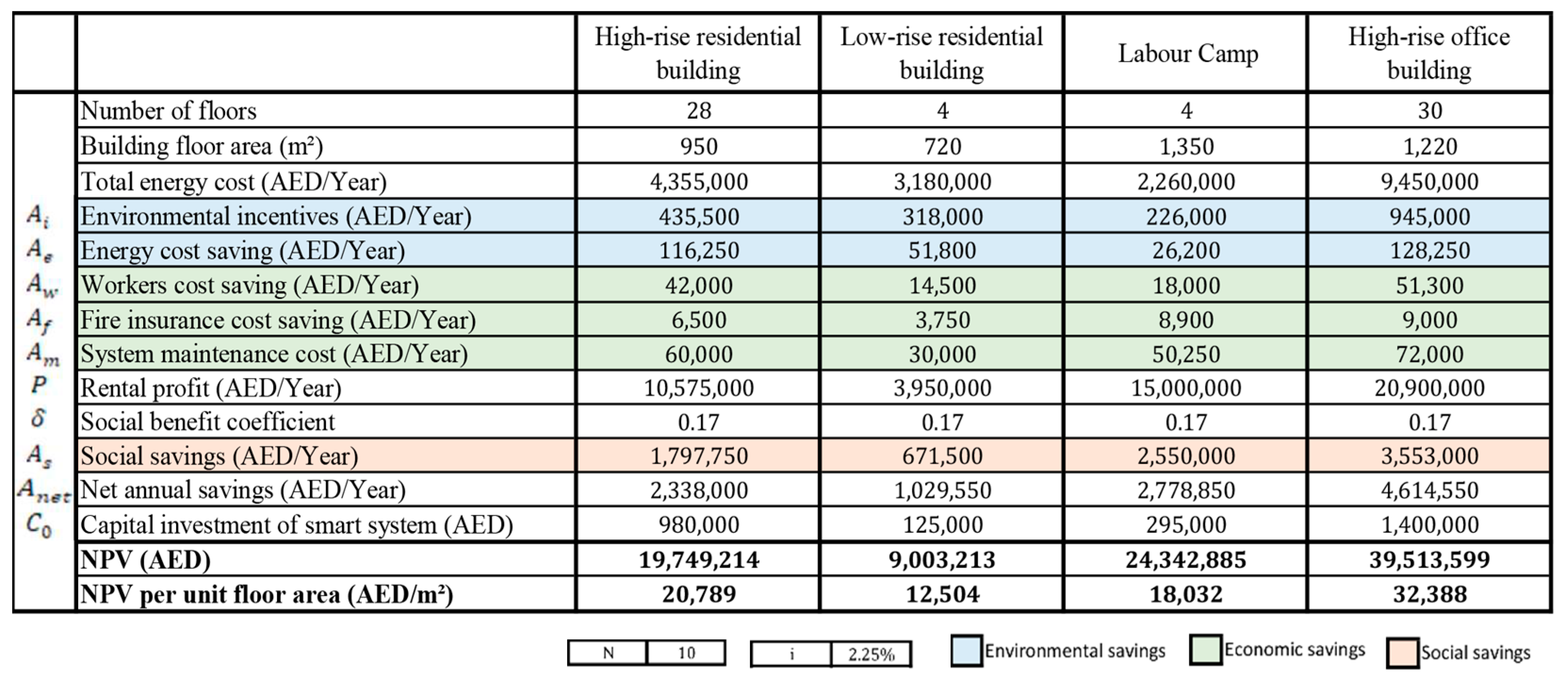
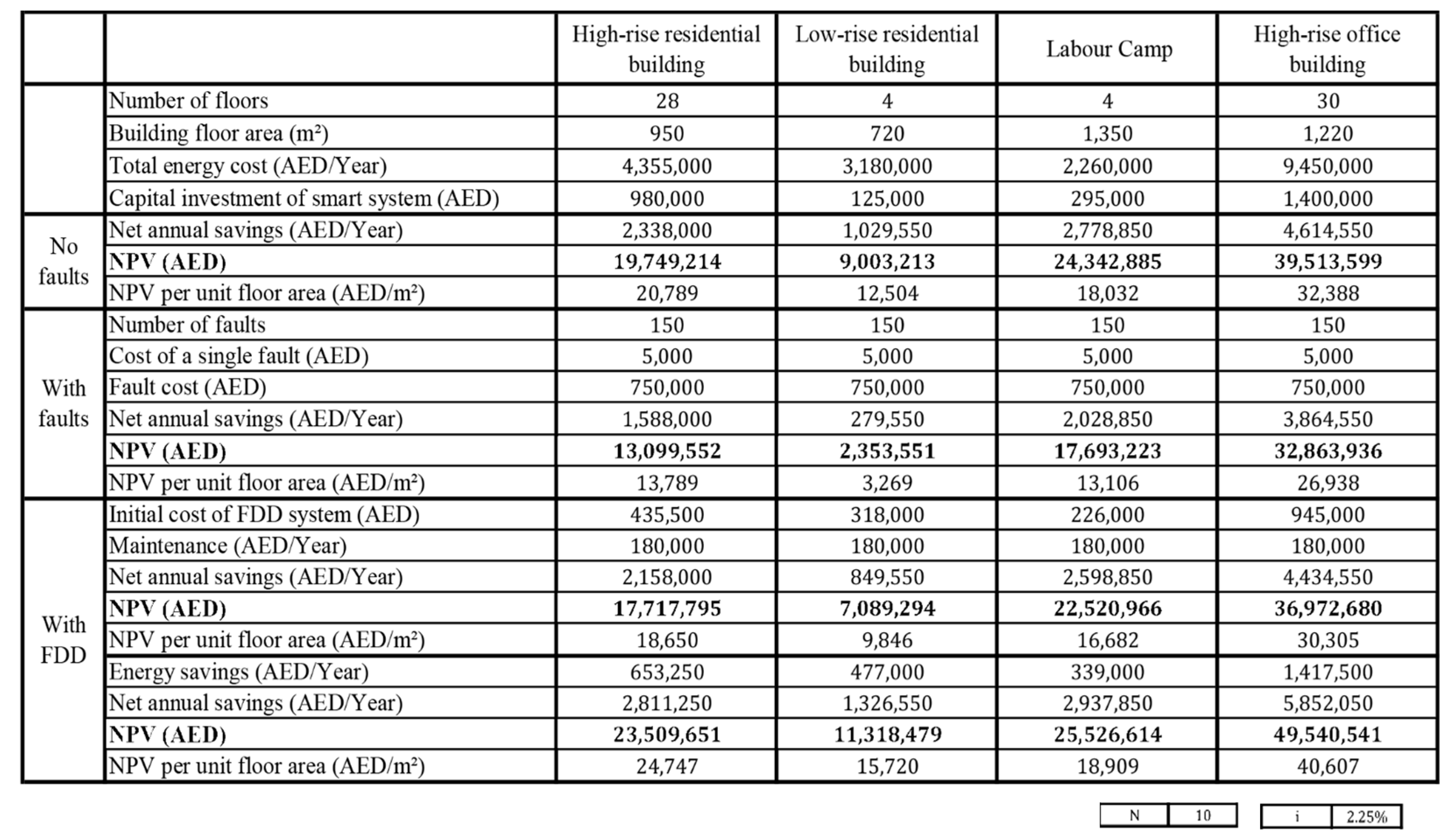



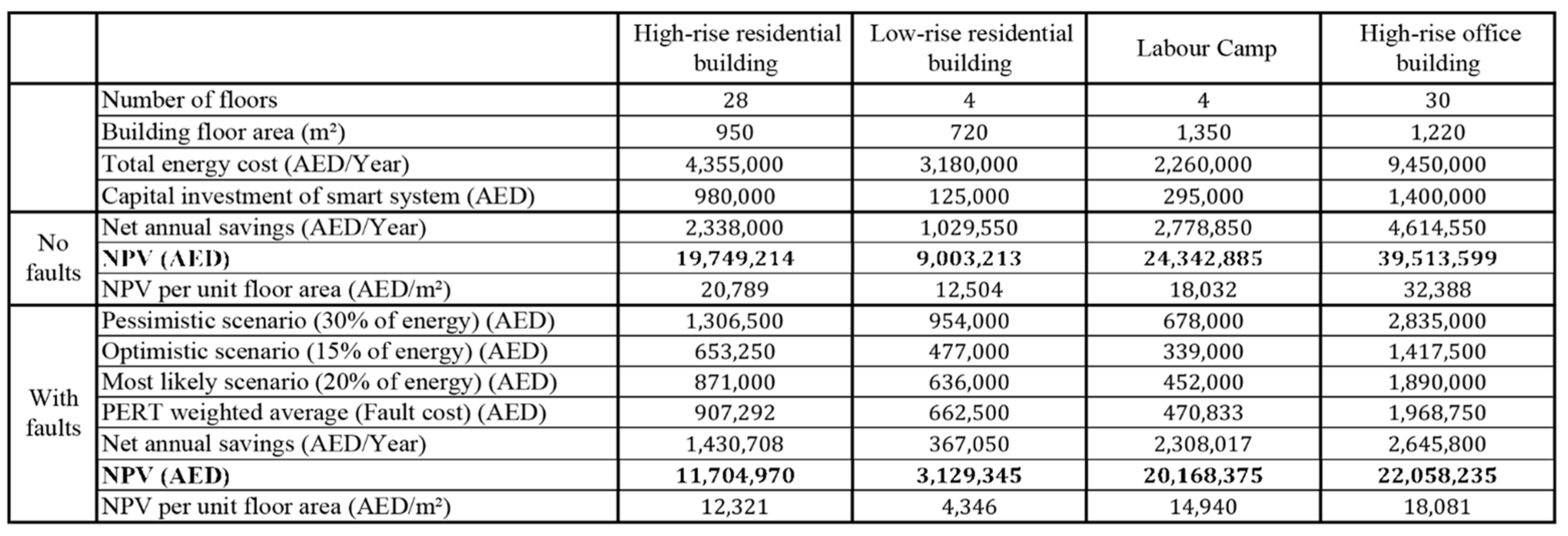


| Study Type | References |
|---|---|
| Cost savings due to implementing smart technologies | [6] and [34,35,36,37,38,39] |
| Cost savings due to implementing sustainable approaches | [34,35,36,37,38,39] |
| Cost savings due to implementing smart and resilient technologies | [30] and [40,41,42,43] |
| Cost savings due to implementing smart technologies and sustainable approaches and maintaining their resilience | [6,44] |
| Attribute | Reference |
|---|---|
| Energy expenditure | [46,47] |
| Environmental incentives | [47,48] |
Disclaimer/Publisher’s Note: The statements, opinions and data contained in all publications are solely those of the individual author(s) and contributor(s) and not of MDPI and/or the editor(s). MDPI and/or the editor(s) disclaim responsibility for any injury to people or property resulting from any ideas, methods, instructions or products referred to in the content. |
© 2024 by the authors. Licensee MDPI, Basel, Switzerland. This article is an open access article distributed under the terms and conditions of the Creative Commons Attribution (CC BY) license (https://creativecommons.org/licenses/by/4.0/).
Share and Cite
Al Qurneh, D.A.; AbuMoeilak, L.; Beheiry, S.; Mortula, M. Coupling and Quantifying Sustainability and Resilience in Intelligent Buildings. Sustainability 2024, 16, 3175. https://doi.org/10.3390/su16083175
Al Qurneh DA, AbuMoeilak L, Beheiry S, Mortula M. Coupling and Quantifying Sustainability and Resilience in Intelligent Buildings. Sustainability. 2024; 16(8):3175. https://doi.org/10.3390/su16083175
Chicago/Turabian StyleAl Qurneh, Deena Ahmed, Lama AbuMoeilak, Salwa Beheiry, and Maruf Mortula. 2024. "Coupling and Quantifying Sustainability and Resilience in Intelligent Buildings" Sustainability 16, no. 8: 3175. https://doi.org/10.3390/su16083175






